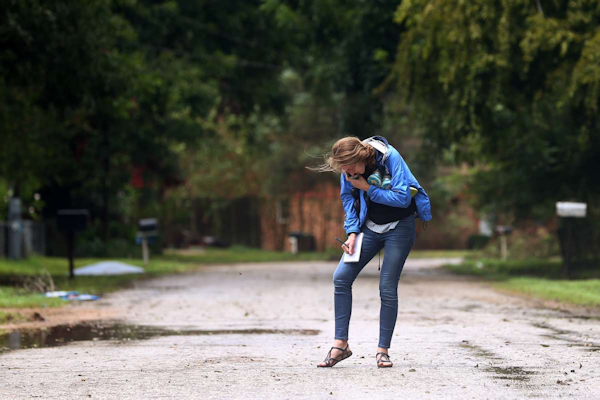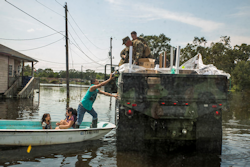SEJournal Online is the digital news magazine of the Society of Environmental Journalists. Learn more about SEJournal Online, including submission, subscription and advertising information.
 |
 |
| Houston Chronicle reporter Emily Foxhall works in Fort Bend County during Hurricane Harvey. Photo: Godofredo Vásquez/Houston Chronicle. |
Feature: Storm Warning — How To Prepare for Weather Disaster Reporting
By Emily Foxhall
As Hurricane Harvey pushed up the Gulf coast on August 26, 2017, I was driving out to suburban Houston in the dark. I had never covered a hurricane before. But my editor had called to tell me I needed to get out there in case the levees failed and no one could reach the area. Being young and eager to get the story, I went.
 |
| Following Hurricane Harvey, a family in a flooded Texas neighborhood receives supplies. Photo: U.S. Marine Corps / Lance Cpl. Niles Lee via Flickr (Public Domain). |
Despite days of warnings of the approaching storm, I headed out woefully unprepared (may require subscription). I grabbed what little food I happened to have in the pantry. I made no plans for where to sleep. Rain pounded my windshield. The police closed the highway in front of me because it wasn’t safe to drive on anymore.
I stayed in a Red Cross shelter that night — taking up space that wasn’t really meant for me. I spent the night listening to emergency alerts blare on phones, scrolling through tweets about people stuck in their attics as floodwaters rose and worriedly wondering what the next day would bring.
I learned the hard way that preparation is key to covering any disaster successfully. The physical, emotional and professional strain is hard enough. Being ready with food, supplies and reporting plans makes a world of difference to those on the ground.
Balancing storm reporting’s value with its risks
Reporting in a community following a storm can help your audience truly understand what happened to people and why it matters.
The scenes I’ve come upon while covering storms are some I will never forget. A woman drying out a family Bible. Water marks in homes well above someone’s head. The stench of mold. A ruined wedding dress. People emerging bleary-eyed after surviving the howling winds and lashing rain in an evacuation zone all night.
But it’s important to set boundaries. Never risk your life for a story. I don’t get in boats with strangers or drive through high water. You know what you’re experiencing on the ground and what it makes sense to pursue or not.
In hopes that no other reporter makes the same mistakes I made, here are my tips on how to cover a storm. They’ll help you in any disaster.
Prepare supplies and food well ahead
My guiding principle for reporters in the field: Be prepared to rely on yourself for everything, as if you were spending a week camping.
Step one happens before disaster hits. Newsrooms need to organize go-bags for reporters with essential supplies. Reporters who will be assigned to disaster coverage should get stipends to purchase nonperishable food to last however long they will be there.
Some supplies I’ve found especially helpful include a power inverter to charge devices in your car, a flashlight or lantern with extra batteries, a first-aid kit, sunscreen and bug spray, quick-drying clothes, rain gear, waterproof bags for a phone and notebooks, thick-soled shoes to walk safely in debris-strewn floodwater — and lots of extra socks.
When it comes to food,
I recommend getting items you
actually want to eat so you have
a little pick-me-up during trying days.
When it comes to food, I recommend getting items you actually want to eat so you have a little pick-me-up during trying days. For me, that’s rice crackers, peanut butter, soup, olives, pickles, popcorn, chocolate and dehydrated or canned fruit. Restaurants likely won’t be serving food for days and any open grocery stores will have long lines. You don’t want to take emergency food others might need.
Other tricks I’ve learned: Carry cash in case you need to buy something but there isn’t power to run credit card machines. Don’t forget utensils. Pack so much water you could never be close to worrying you’ll run out.
Make a reporting plan when the disaster looms
Meteorologists know when a hurricane is approaching, giving newsrooms time to plan. Other disasters might not have the same lead time. No matter how rushed you are, before leaving to cover any emergency, try to take the time to do the following:
- Fill your gas tank.
- Be sure your spare tire is full of air.
- Charge devices and back up power banks.
- Download Maps.Me for offline map access.
- Talk with those in your newsroom about how they can help while you’re on the ground.
While you’re focused on the victims and the survivors, reporters in the newsroom can help you figure out where to go next or provide helpful context about a certain city or neighborhood where you’re spending time.
Colleagues can also help by watching news conferences, quickly filing the necessary public information requests and finding you a safe place to stay (this could be with first responders early on; hotels will need to be booked quickly because they fill up after disasters). They might also pull needed context on how climate change affects what happened.
Know this will still be hard, and that’s OK
Being ready will help make disaster coverage as smooth as it can be. I’ve found it’s still important to give myself patience and grace when working through it.
By the time I covered Hurricane Laura in 2020, I thought I had all of this down. I’d covered several disasters by that point. I’d trained younger colleagues on how to cover hurricanes. I had my supplies ready. I knew contacts in the area who could help me get around flooded spots.
I still faced difficulty.
I slept in a school cafeteria with first responders (may require subscription) in East Texas before driving as the sun rose to cover the immense wreckage that Hurricane Laura had left behind in Louisiana.
On the way, we passed through a cloud of what turned out to be dangerous chemical gas, managing to turn on the internal air circulation in the car just in time.
When Laura hit, it took countless electricity poles down. That meant we had no cell service in a large swath of the Lake Charles area we covered. One afternoon, I didn’t leave myself enough time to get somewhere with cell service so I could file what I’d been reporting for the next day’s paper.
In moments such as those, I try
to give myself grace. These are
disaster scenarios, when society
isn’t functioning like it should.
In moments such as those, I try to give myself grace.
These are disaster scenarios, when society isn’t functioning like it should, when we are witnessing people facing immense loss, when we are navigating dangerous scenarios on our own.
Returning home, you need time to process. And the experience might still stick with you. I find myself tense up even now when I hear the emergency warnings set off phone alarms or when heavy rain falls fast.
I’m glad to hear editors talk about prioritizing the wellbeing of reporters and how to support them through this type of work. If that conversation isn’t happening in your newsroom, it may be time to get it started.
Climate change is only making this kind of disaster coverage more necessary. We owe it to ourselves and our industry to be ready.
Emily Foxhall joined The Texas Tribune as the energy reporter in December 2022. She's focused on the state’s transition to green energy and is based in Houston. Foxhall began her career at the Los Angeles Times and its community papers, then later worked at the Houston Chronicle, where her environmental reporting uncovered the effects of climate change and pollution on the region. She won several Texas Managing Editors awards and was part of the 2017 team that was named a finalist for the Pulitzer Prize for breaking news coverage of Hurricane Harvey. Foxhall graduated from Yale University in 2013.
* From the weekly news magazine SEJournal Online, Vol. 8, No. 31. Content from each new issue of SEJournal Online is available to the public via the SEJournal Online main page. Subscribe to the e-newsletter here. And see past issues of the SEJournal archived here.











 Advertisement
Advertisement 



